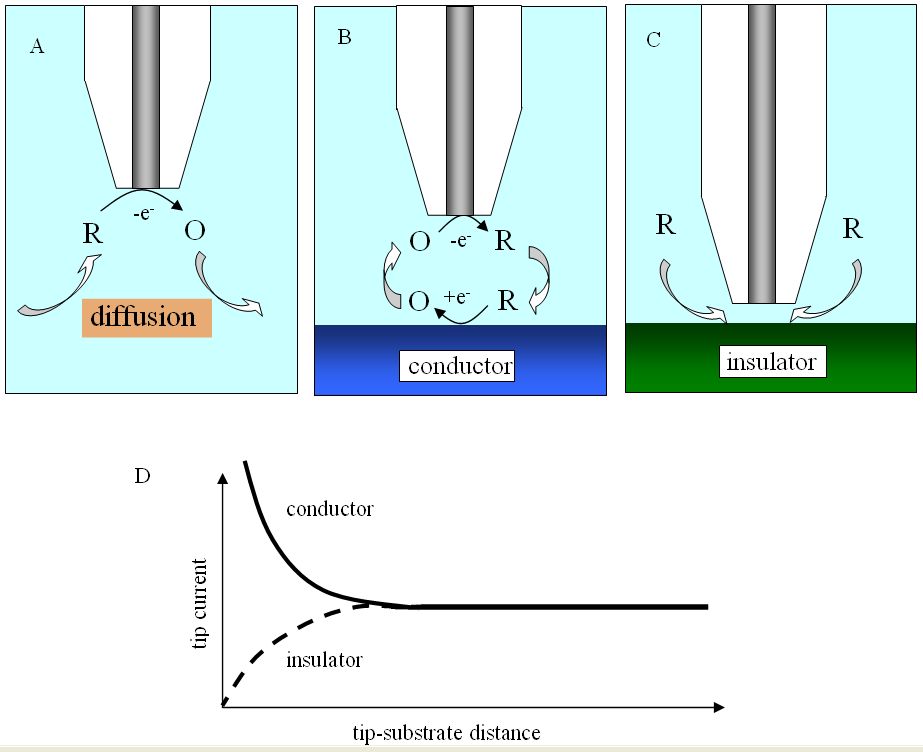Scanning Electrochemical Microscopy: Probing Interfaces at the Nanoscale
What is Scanning Electrochemical Microscopy?
Scanning electrochemical microscopy (SECM) is a powerful analytical technique that combines the principles of electrochemistry and scanning probe microscopy to study interfacial processes at the nanoscale. It enables the investigation of local electrochemical properties, such as reaction rates, ion transport, and surface reactivity, with high spatial resolution and sensitivity.

Key Components of SECM
SECM consists of several key components that work together to enable high-resolution electrochemical measurements:
- Ultramicroelectrode (UME): The UME is the heart of the SECM system. It is a small electrode, typically with a diameter in the range of nanometers to micrometers, that serves as the probe for measuring local electrochemical properties. The UME can be made of various materials, such as platinum, gold, or carbon, depending on the specific application.
- Positioning System: The UME is mounted on a precise positioning system that allows for controlled movement in three dimensions. This positioning system, often based on piezoelectric actuators, enables the UME to be scanned across the sample surface with nanoscale resolution.
- Electrochemical Cell: The sample under investigation is placed in an electrochemical cell that contains an electrolyte solution. The cell also includes a reference electrode and a counter electrode to complete the electrochemical circuit.
- Feedback System: SECM operates in a feedback mode, where the UME is used to both perturb the sample surface and measure the resulting electrochemical response. The feedback system monitors the current or potential at the UME and adjusts the UME position to maintain a constant distance from the sample surface.
Operating Modes of SECM
SECM can be operated in different modes depending on the specific application and the type of information desired:
Feedback Mode
In the feedback mode, the UME is positioned close to the sample surface, and the current or potential at the UME is monitored as it is scanned across the surface. The presence of the sample affects the electrochemical response at the UME, providing information about the local electrochemical properties. This mode is commonly used for imaging surface reactivity, studying electron transfer kinetics, and mapping concentration profiles.
Generation/Collection Mode
In the generation/collection mode, the UME is used to generate a species at the sample surface, while a second electrode (the collector) is used to detect the generated species. This mode is useful for studying the transport and reaction of species near the sample surface, as well as for investigating the catalytic activity of materials.
Potentiometric Mode
In the potentiometric mode, the UME is used as a local pH or ion-selective electrode to measure the concentration of specific ions near the sample surface. This mode enables the mapping of local pH or ion concentration profiles, which can provide insights into surface reactions and corrosion processes.
Applications of SECM
SECM has found wide-ranging applications in various fields, including:
Materials Science
SECM is used to study the electrochemical properties of materials at the nanoscale, such as corrosion resistance, surface reactivity, and catalytic activity. It enables the characterization of local heterogeneities and defects in materials, which can provide valuable insights for materials design and optimization.
Biological Systems
SECM is applied to investigate biological processes at the cellular and subcellular level. It can be used to study the release of neurotransmitters, measure the respiratory activity of cells, and map the distribution of enzymes or receptors on cell surfaces. SECM provides a non-invasive and spatially resolved approach to study living systems.
Energy Storage and Conversion
SECM plays a crucial role in the development and characterization of advanced energy storage and conversion devices, such as batteries, fuel cells, and solar cells. It enables the investigation of charge transfer processes, ion transport, and reaction mechanisms at electrode-electrolyte interfaces, providing valuable insights for device optimization and performance enhancement.
Challenges and Future Perspectives
Despite the remarkable capabilities of SECM, several challenges need to be addressed to further advance its applications. One of the main challenges is the fabrication of robust and reproducible UMEs with well-defined geometries and small dimensions. The development of novel UME materials and fabrication techniques is crucial for extending the range of measurable species and improving the spatial resolution.
Future research in SECM will focus on the integration of SECM with other complementary techniques, such as Raman spectroscopy, atomic force microscopy, and mass spectrometry, to provide a more comprehensive understanding of interfacial processes. The combination of SECM with in situ and operando characterization methods will enable real-time monitoring of dynamic processes and provide new insights into the fundamental mechanisms governing nanoscale phenomena.
Further Reading
Chemical Reviews, Scanning Electrochemical Microscopy: A Comprehensive Review of Experimental Parameters
Materials Chemistry Frontiers, Basics of the scanning electrochemical microscope and its application in the characterization of lithium-ion batteries
